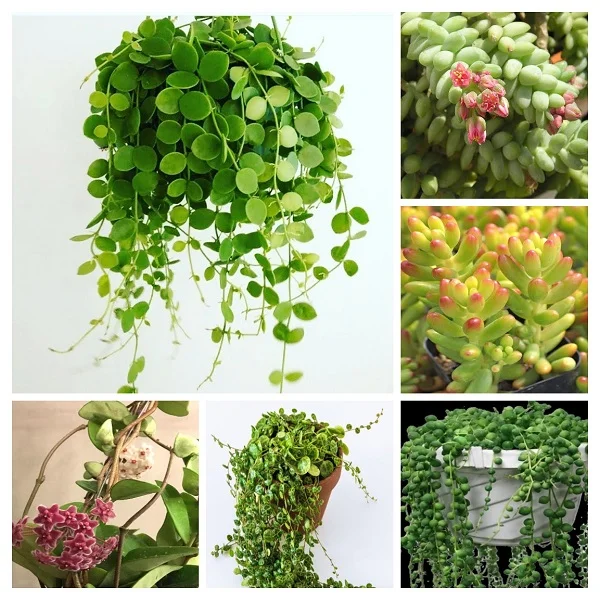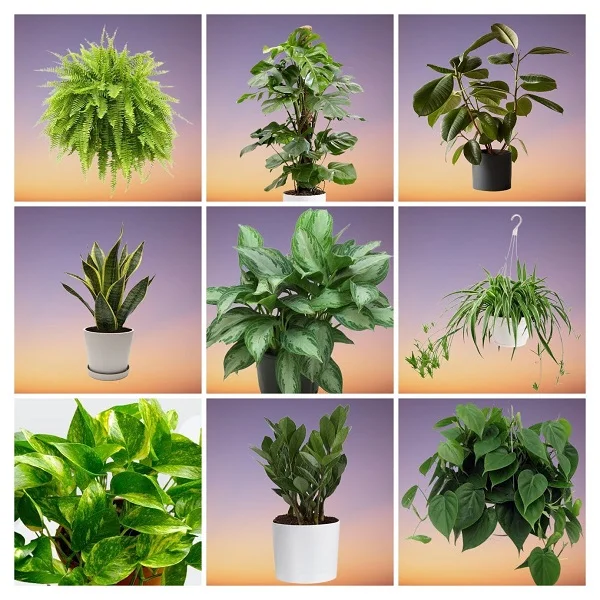20 Best Cascading Flowers for Hanging Baskets with Names and Pictures
Some links in this post may be affiliate links
Trailing flowering plants are delightful in a hanging basket and are a perfect way of adding a splash of color and pleasant scents in any space. Flowering plants have their origin in the tropics and will require warm and humid conditions to thrive and bloom.
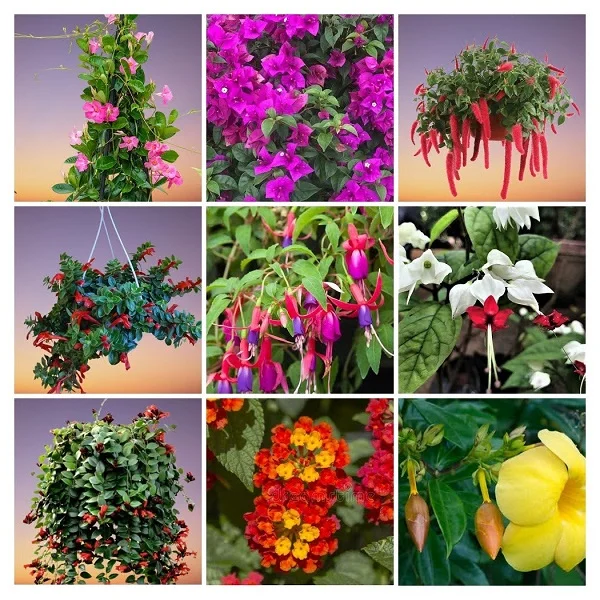
Position your flowering plants under very bright light like infront of a brightly lit window, in the patio, porch, sunroom and other suitable spots as bright light is necessary to promote flowering.
To keep your trailing flowers thriving, keep in mind that the air above is much warmer and drier than at the floor and windowsill level. This means that the hanging basket plants may need more frequent watering than other plants in the same room.
If you are looking to add these plants to your collection, we have herebelow outlined for you 20 of the best cascading flowering plants for hanging to make it easier for you to make your selection.
20 Trailing Hanging Basket Flowering Plants
Best trailing flowers for hanging baskets are Trailing Kalanchoe, Ivy Geranium, Fuchsia Plant, Paper Flower, Common Lantana, Goldfish Plant, Madagascar Jasmine, Black-eyed Susan among others.
1. Trailing Kalanchoe
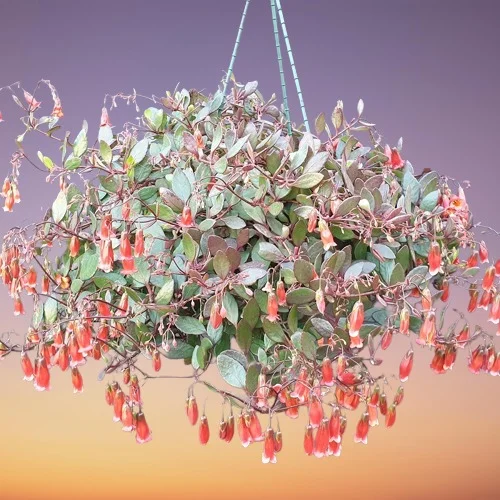
Botanical name: Kalanchoe uniflora
Common names: Trailing Kalanchoe, Coral Bells, Coral Berry, Winter Bells
Origin: Madagascar
Size: 3 feet
Trailing Kalanchoe is one of the popular Kalanchoe varieties and bears pendulous stems and colorful flowers which hang down beautifully in a hanging basket.
Winter Bells creates a magnificent display in a hanging basket or on a pedestal with its fleshy, bright-green leaves and bright-red to red-violet, bell-shaped flowers.
Kalanchoe uniflora blooms in bright light with 4-6 hours of direct sunshine, warmth of 18-280C, humidity of 50-55% and moderately moist, rich, loose, free-draining, succulents potting soil coupled with fortnightly feeding in the growing season.
Learn more on how to grow and care for Trailing Kalanchoe
2. Ivy Geranium

Botanical name: Pelargonium peltatum
Common names: Ivy Geranium, Ivy-leaved Pelargonium, Cascading Geranium
Origin: Southern and Eastern South Africa
Size: 7 feet
Ivy Geranium bears trailing stems, heart-shaped, glossy leaves and large, white to mauve, umbel-like inflorescences which look spectacular in a hanging basket, on a pedestal or up a trellis.
Ivy-leaved Pelargonium like Geraniums (Pelargonium x hortorum) are prolific bloomers with magnificent foliage and large, delightful flowers which may be single, semi-double or double.
Pelargonium peltatum blossoms in bright light to full sun, warmth of 15-280C, humidity of 50-55% and moderately moist, rich, well-drained potting soil coupled with fortnightly feeding in the growing season.
Read more on how to grow and care for Ivy Geranium
3. Fuchsia Plants
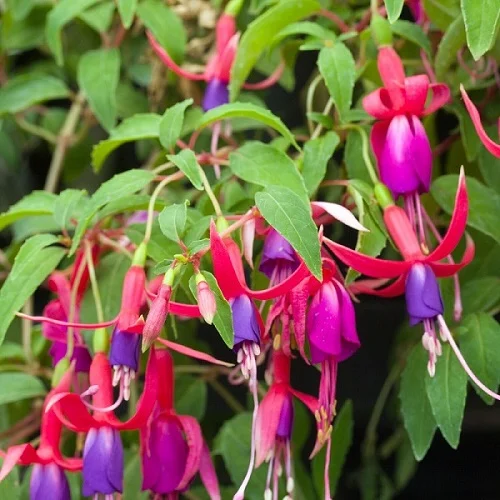
Botanical name: Fuchsia hybrida
Common name: Fuchsia Plant
Origin: South America, Central America, Newzealand
Size: 2-3 feet
Fuchsia are popular flowering plants whose trailing, soft stems and vibrant blooms of showy sepals and petals cascade downwards beautifully in a hanging basket.
The blooms may be single, semi-double, double bells or clustered blooms borne on soft-stemmed bushes. To keep it blooming, avoid moving it during flowering and bud formation as it can result in the dropping of buds and flowers.
Fuchsia hybrida flourishes in bright indirect light (filtered light), warmth of 15-230C, humidity of 50-55% and consistently moist, rich, well-drained soil coupled with fortnightly feeding during the growing season.
Learn more on how to grow and care for Fuchsia hybrida
4. Trailing Velvet Plant
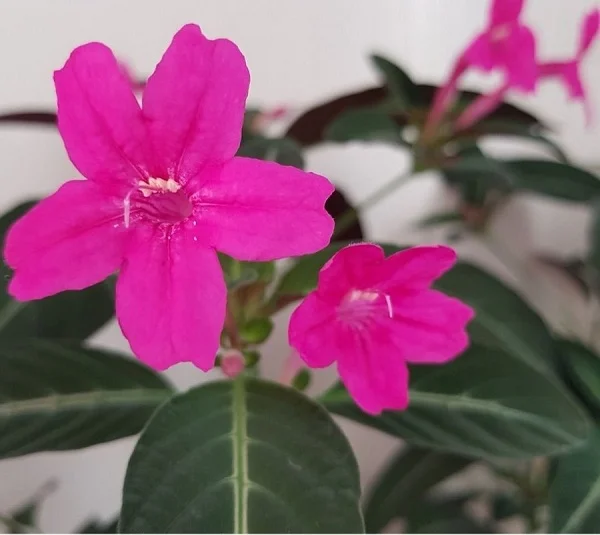
Botanical name: Ruellia makoyana
Common name: Trailing Velvet Plant, Monkey Plant
Origin: Brazil
Size: 2 feet
Trailing Velvet Plant bears 2 feet long, drooping stems, long, flared, trumpet-shaped flowers and velvety, oval-shaped leaves tinged with purple and veined in silver which are spectacular in a hanging baskets.
Monkey Plant requires regular pruning to keep it neat, to encourage a bushy growth and to rejuvenate growth. Repotting is only needed when it becomes extremely root-bound as it blooms best when slightly pot-bound.
Ruellia makoyana prospers in bright indirect light (dappled light), warmth of 18-240C, humidity of 60-70% and consistently moist, fertile, well-drained soil coupled with monthly feeding during the growing season.
Read more on how to grow and care for Trailing Velvet Plant
5. Paper Flower
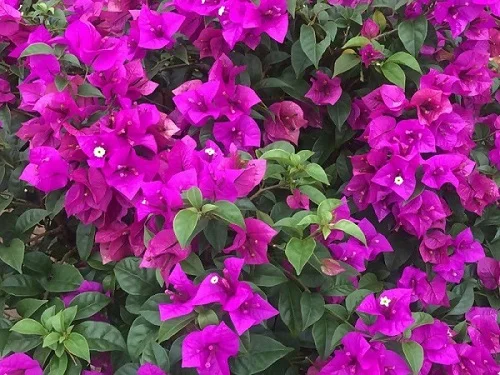
Botanical name: Bougainvillea glabra
Common name: Paper Flower
Origin: Brazil
Size: 12 feet
Paper Flower is among the popular flowering plants and bears trailing stems and bright showy blooms which look magnificent in a hanging basket.
Bougainvillea come in many hybrids like Mrs Butt with large leaves and large, rose-crimson-flowers, Magnifica which is purple, Raspberry Ice whose flowers are a ravishing red and Alexendra which is pink among others.
Bougainvillea glabra blossoms in very bright light with at least 4-6 hours of sunshine, warmth of 16-270C, humidity of 50-55% and moderately moist, fertile, well-drained soil coupled with fortnightly feeding in the growing season.
Learn more on how to grow and care for Paper Flower Plant
6. Common Lantana
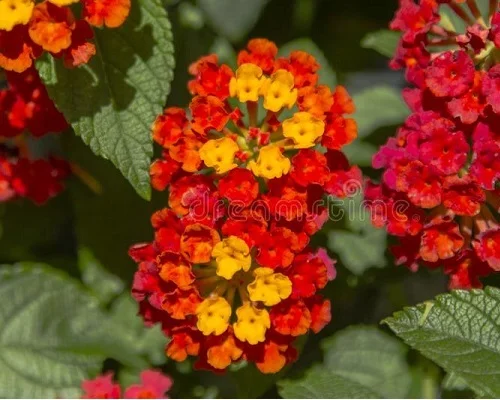
Botanical name: Lantana camara
Common names: Common Lantana, Shrub Verbena, Wild Sage, Tick Berry
Origin: Central and South America
Size: 6 feet
Common Lantana is a perennial, erect, fast-growing, sprawling shrub which bears broadly, ovate leaves with a strong citrusy smell and small, tubular-shaped flowers in clusters in terminal areas of the stem and are magnificent in a hanging basket.
Numerous varieties (cultivars) of Shrub Verbena have been developed including Miss Huff, Mozelle, Gold Mountain, Patriot Honeylove, Clear White, Cape Hill Gold among others.
Lantana camara thrives in full sun with at least 6-8 hours of sunshine per day, warmth of 12-300C, average humidity and consistently moist, neutral soil that is well-drained coupled with one feeding in the growing season.
Read more on how to grow and care for Lantana camara
7. Goldfish Plant
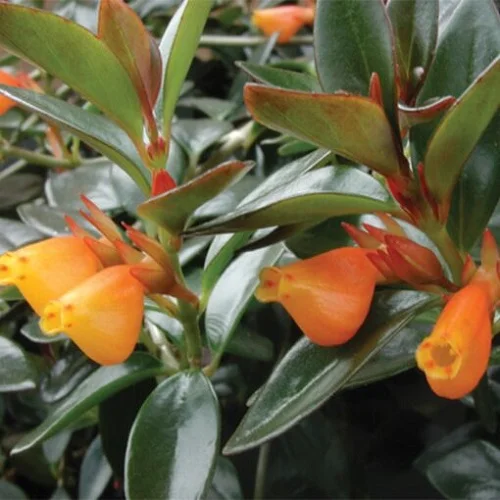
Botanical name: Columnea gloriosa
Common names: Goldfish Plant
Origin: Tropical America and the Caribbean
Size: 3 feet
Goldfish Plant is an evergreen, trailing plant which bears glossy, dark-green leaves and abundant yellow or orange-red tubular flowers making it perfect for hanging baskets.
To encourage blooming and lush growth maintain a moist atmosphere, feedd it regularly over the growing period and cutback the stems once flowering is over. Repot only when the plant is pot-bound as it blooms best when root-bound.
Columnea gloriosa flourishes in bright indirect light (filtered light), warmth of 18-260C, humidity of 60-70% and moderately moist, fertile, well-drained potting soil coupled with fortnightly feeding in the growing season.
Learn more on how to grow and care for Goldfish Plant
8. Madagascar Jasmine
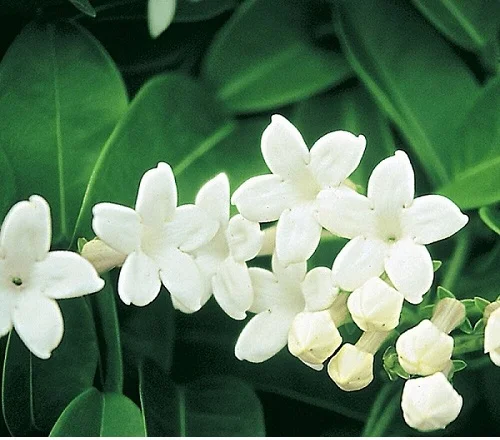
Botanical name: Stephanotis floribunda
Common names: Madagascar Jasmine, Hawaiian Wedding Flower, Bridal Wreath, Clustered Wax Flower, Bridal Veil Vine
Origin: Madagascar
Size: 20 feet
Madagascar Jasmine is a vigorously-growing, climbing, flowering plant with white, waxy, star-shaped, tubular, sweet-scented flowers and will flourish in a hanging basket.
Though called Jasmine, Madagascar Jasmine is not a Jasmine. It belongs to the family Apocynaceae (Dogbane family). True Jasmines belong to the family Oleaceae (Olive family).
Stephanotis floribunda blooms in bright light with 4-6 hours of direct sunshine, warmth of 20-250C, humidity of 55-65% and consistently moist, rich, well-drained soil coupled with monthly feeding during the growing season.
Read more on how to grow and care for Madagascar Jasmine
9. Golden Trumpet

Botanical name: Allamanda cathartica
Common names: Golden Trumpet, Common Trumpetvine, Yellow Allamanda
Origin: Brazil
Size: 20 feet
Golden Trumpet is a climbing, flowering plant which bears glossy leaves and flaring, yellow trumpet-like flowers and is spectacular in a hanging basket.
Several varieties of Yellow Allamanda which include grandiflora which has more compact, pale-yellow flowers and handersonii which has red buds and golden yellow flowers.
Allamanda cathartica performs best in bright light with 4 hours of direct sunshine, warmth of 16-270C, humidity of 60-70% and moderately moist, fertile, well-drained soil coupled with fortnightly feeding during the growing season.
Learn more on how to grow and care for Golden Trumpet
10. Black-eyed Susan

Botanical name: Rudbeckia hirta
Common names: Black-eyed Susan, Yellow Daisy, English Bull's Eye, Brown-eyed Susan, Brown Betty, Golden Jerusalem, Gloriosa Daisy, Ox-eye Daisy
Origin: Eastern and Central North America
Size: 1-3 feet
Black-eyed Susan is a fast-growing, 3 feet tall plant with alternate leaves covered with coarse hairs and daisy-like composite flower heads and one of the best plants for hanging baskets.
Yellow Daisy belongs to the Asteraceae (Daisy) family formerly Compositae family together with Purple Coneflower (Echinacea purpurea), Sunflower, Aster, Dahlias and Daisy.
Rudbeckia hirta grows best in in full sun with at least 6-8 hours of sunshine per day, warm and dry conditions and moderately moist, well-drained soil with occasional feeding to promote a lush growth.
Read more on how to grow and care for Black-eyed Susan
11. Queen's Tears Bromeliads
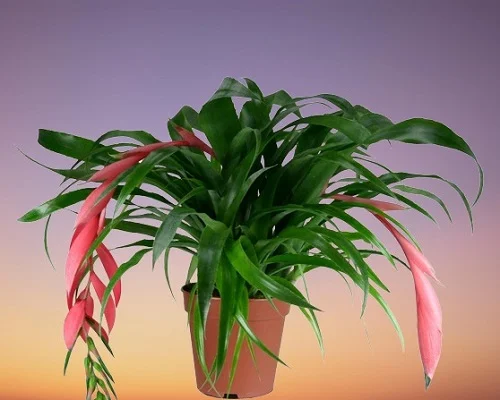
Botanical name: Billbergia
Common names: Queen's Tears Bromeliad, Friendship Plant
Origin: Brazil, Paraguay, Uruguay, Argentina
Size: 1 foot
Queen's Tears Bromeliad is one of the easiest Bromeliad varieties and is grown for the beauty of its drooping, showy, flower-heads which drip nectar and leathery, arching, one ft long, grass-like leaves which hang downwards beautifully in a hanging basket.
Popular of the Billbergia Bromeliads include Billbergia nutans, Billbergia windii which is larger, with the flower-stalks being about 18 inches long and the foliage is grey-green.
Billbergia Bromeliads flourish in bright indirect light, warmth of 18-280C, humidity of 60-70% and moderately moist, rich, well-drained orchids potting soil coupled with fortnightly feeding in the growing season.
Learn more on how to grow and care for Queen's Tears Bromeliads
12. Christmas Cactus
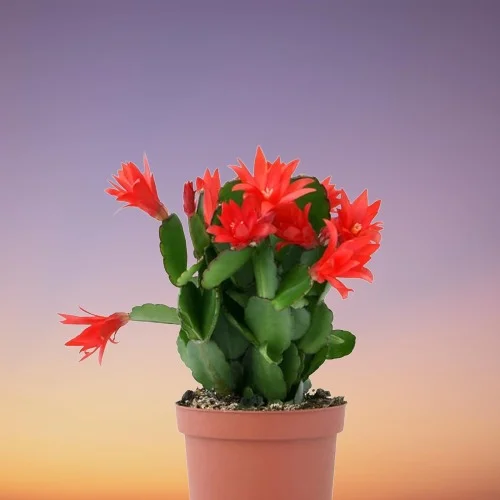
Botanical name: Schlumbergera x buckleyi
Common names: Christmas Cactus, Holiday Cactus, Crab Cactus
Origin: South America
Size: 1 foot
Christmas Cactus bears fleshy segmented stems, slightly serrated on each side and flowers at the ends of the stems which hang downwards beautifully in hanging baskets.
The stems in Christmas Cactus are flattened leaves. The original flower color is red but hybrids may come in pink, purple, white and other colors.
Schlumbergera x buckleyi prospers in bright filtered light, warmth of 18-260C, humidity of 55-65% and moderately moist, rich, loose, free-draining cactus potting soil coupled with monthly feeding during the growing season.
Read more on how to grow and care for Christmas Cactus
13. Bluecrown Passionflower
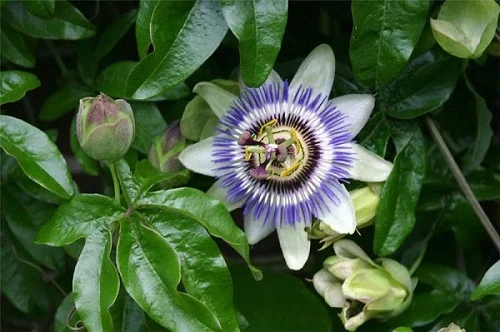
Botanical name: Passiflora caerulea
Common name: Bluecrown Passionflower, Blue Passionflower, Southern Beauty, Wild Apricot, Jesus Flower, Passion Flower
Origin: Rain forests of Brazil and Argentina
Size: 6-10 feet
Bluecrown Passionflower is a rampant, climber whose stems bear deeply-lobed leaves, tendrils and short-lived flowers all through the growing season and is ideal for a hanging basket.
The flowers in Bluecrown Passionflower are fragrant, blue-white with a prominent fringe of filaments in bands of blue, white and brown. The fruits are orange, small, oval-shaped, edible but bland.
Passiflora caerulea blossoms in bright light with 4-6 hours of direct sunlight, warmth of 18-270C, humidity of 60-70% and consistently moist, rich, free-draining soil coupled with monthly feeding in the growing season.
Learn more on how to grow and care for Bluecrown Passionflower
14. Mandevilla
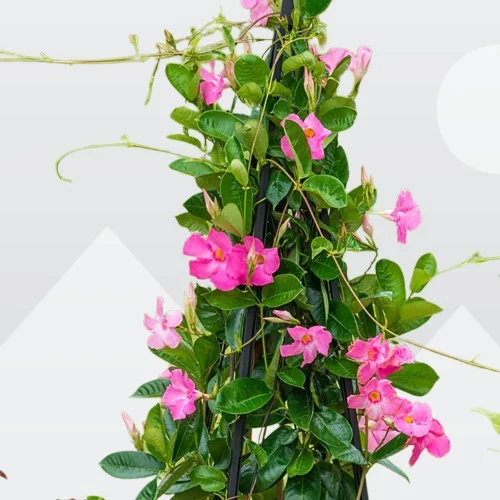
Botanical name: Mandevilla
Common names: Rock Trumpet
Origin: Southwestern United States, Mexico, Central America, the West Indies, and South America
Size: 10 ft
Mandevilla are evergreen, climbing plants whose stems are densely covered with glossy, dark-green oval leaves and bears brightly colored, large, trumpet-shaped flowers which come in white, pink, yellow, red or mixed colors.
The vining stems and large flowers beautifully cascade downwards in a hanging basket or on a pedestal. They can also be allowed to climb up a trellis. On account of its magnificent flowers, Rocktrumpets are among the best plants for the front porch or entrance.
Mandevilla Plants grow best in bright light with 6-8 hours of direct sunlight, warmth of 18-300C, humidity of 60-70%, and consistently moist, rich, well-drained soil coupled with fortnightly feeding during the growing season.
Read more on how to grow and care for Mandevilla Plants
15. Wax Plant
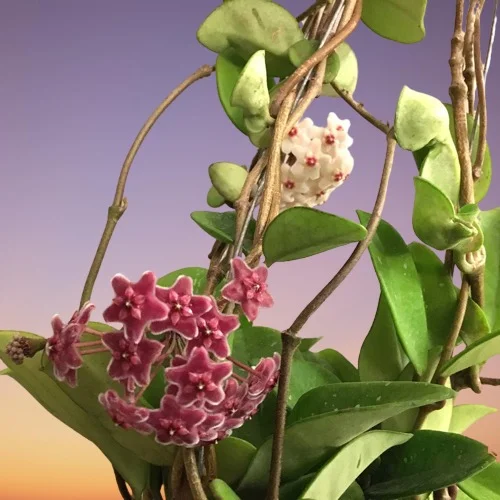
Botanical name: Hoya carnosa
Common names: Wax Plant, Porcelainflower
Origin: Eastern Asia, Australia
Size: 15 feet
Wax Plant is climbing, flowering plant which bears fleshy leaves and and twining stems which can reach 15 feet or more making it perfect for a hanging basket.
Hoya carnosa is among the popular Hoya varieties grown for their beautiful leaves and large flowerheads made up of waxy, fragrant and star-shaped flowers.
Hoya carnosa prospers in bright light with with 4-6 hours of direct sunlight, warmth of 16-260C, humidity of 50-55% and moderately moist, fertile, well-drained hoya potting soil coupled with monthly feeding in the growing season.
Learn more on how to grow and care for Wax Plant
16. Pink Jasmine
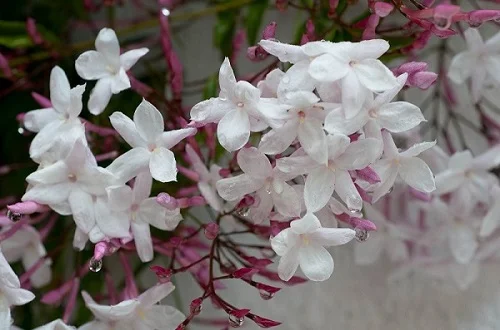
Botanical name: Jasminum polyanthum
Common names: Pink Jasmine, Winter Jasmine, Star Jasmine, French Perfume, Chinese Jasmine, Manyflowered Jasmine
Origin: Southeastern China
Size: 10 feet
Pink Jasmine is a vigorously-growing, climbing, flowering plant which bears fragrant flowers in clusters and is ideal for a hanging basket.
Winter Jasmine is among the easiest to grow Jasmines and is mainly grown for the characteristic fragrance of its flowers and ability to keep off pests and diseases.
Jasminum polyanthum flourishes in bright light with 4-6 hours of direct sunlight, warmth of 18-240C, humidity of 50-55% and consistently moist, rich, well-drained potting soil coupled with fortnightly feeding in the growing season.
Read more on how to grow and care for Pink Jasmine
17. Bleeding Glory Vine
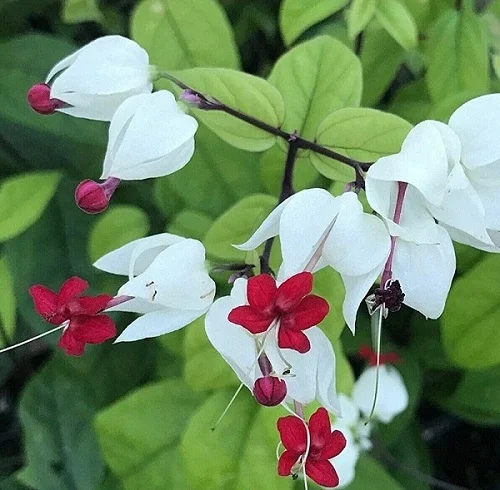
Botanical name: Clerodendrum thomsoniae
Common names: Bleeding Glory Vine, Bleeding Glorybower, Tropical Bleeding Heart, Bagflower, Harlequin Glorybower
Origin: West Africa; Cameroon to Senegal
Size: 6 feet
Bleeding Glory Vine is a perennial climbing plant which bears bell-shaped, lightly scented, two-colored flowers; red and surrounded by white sepals.
The blooms in Harlequin Glorybower are borne in terminal clusters of 8-20 in spring and summer and appear bell-shaped and are lightly scented.
Clerodendrum thomsoniae prospers in bright indirect light(dappled light), warmth of 16-280C, humidity of 60-70% and consistently moist, fertile, well-drained, all purpose soil coupled with monthly feeding during the growing season.
Learn more on how to grow and care for Bleeding Glory Vine
18. Lipstick Plant
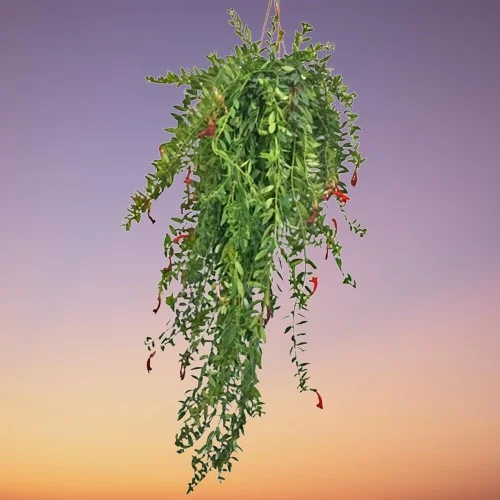
Botanical name: Aeschynanthus radicans
Common name: Lipstick Plant, Lipstick Vine, Basket Vine
Origin: Malay Peninsula south to Java.
Size: 3-5 feet
Lipstick Plant is an evergreen, vining, perennial plant which bears leathery, ovate to lanceolate, green leaves and terminal vibrant red tubular flowers with yellow throats, ideal for a hanging basket where the beautiful leaves and vibrant flowers can be displayed beautifully.
The flowers in Lipstick Vine appear in spring and summer. The common name, 'Lipstick Plant', comes from the scarlet flowers which open from buds that resemble tubes of lipstick.
Aeschynanthus radicans flourishes in very bright light, warmth of 18-280C, humidity of 60-70% and consistently moist, rich, well-drained potting soil coupled with monthly feeding in the growing season.
Read more on how to grow and care for Lipstick Plant
19. Chenille Plant
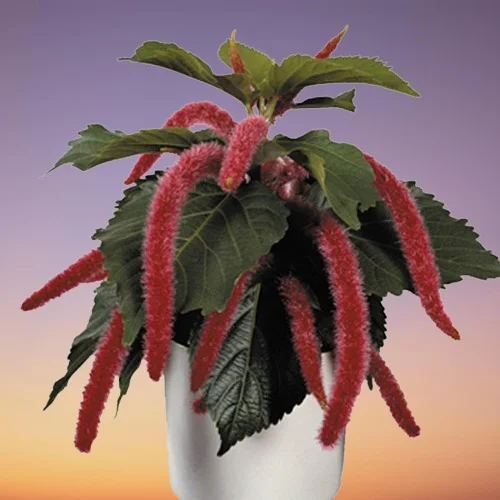
Botanical name: Acalypha hispida
Common names: Chenille Plant, Philippine Medusa, Red Hot Cat Tail, Monkey Tail, Foxtail
Origin: Malesia and Papuasia
Size: 5-8 feet
Chenille Plant is a favorite indoor plant on account of its pendulous, brilliantly colored, furry flowers which are magnificient in a hanging basket or on a pedestal.
Philippine Medusa is dioecious which means that male and female flowers are borne on different plants unlike its relative Acalypha wilkesiana (Copperleaf Plant) which bears both male and female flowers on the same plant.
Acalypha hispida blossoms in bright indirect light (filtered light), warmth of 18-280C, humidity of 55-70%, and moderately moist, fertile, well drained, all purpose potting soil coupled with fortnightly feeding in the growing season.
Learn more on how to grow and care for Chenille Plant
20. Rose Grape

Botanical name: Medinilla magnifica
Common names: Rose Grape, Showy Medinilla, Philippines Orchid, Pink Lantern
Origin: Philippines
Size: 2 feet
Rose Grape bears spectacular, pendant. rosy-pink flower-heads and can be grown in a hanging basket where the flowers can beautifully hang downwards.
The inflorescences in Showy Medinilla are arching panicles of pink flowers, with showy pink basal bracts and are about 1.5 feet long.
Medinilla magnifica prospers in bright indirect light (filterd light), warmth of 16-240C, humidity of 60-70% and moderately moist, fertile, well-drained potting soil coupled with fortnightly feeding in the growing season.
Read more on how to grow and care for Rose Grape (Medinilla magnifica)

